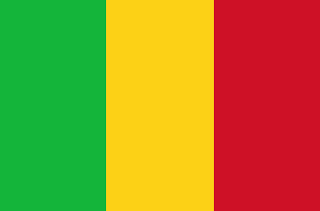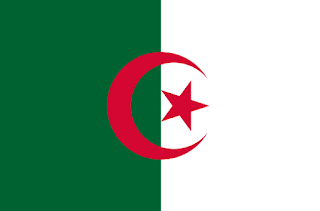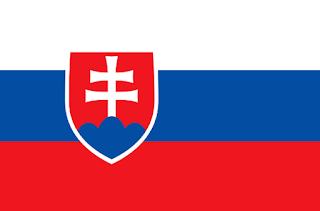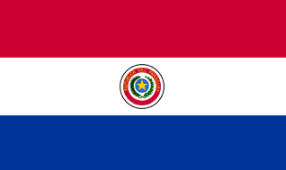FACTS ABOUT MALI
AMAZING
FACTS ABOUT MALI
1.
The official name of Mali is “Republic
of Mali”.
2.
Mali is a landlocked country in West
Africa.
3.
Bamako is the capital city of Mali.
4.
The total population of Mali is 17,885,245.
5.
The natives of Mali are called Malians.
6.
The West African CFA franc (XOF)
is official currency of Mali.
7.
Mali shares a border with Algeria,
Niger, Burkina Faso, Ivory Coast, Guinea, Senegal and Mauritania.
8.
Mali is the world’s 24th
largest country.
9.
Mali is the eighth-largest country in
Africa, comparable in size to the nation of South Africa and almost twice the
size of the U.S. state of Texas.
10.
Mali’s three natural land zones include
the arid Saharan zone, the semiarid central Sahelian zone, and the southern
cultivated Sudanese, where the majority of the country’s population lives.
11.
The thermal equator crosses Mali, making
it one of the hottest countries in the world. Rainfall is negligible and
droughts are frequent.
12.
Most of Mali’s land is flat, rising to
rolling plains in the north that are covered with sand. The majority of the
country is located in the southern part of the Sahara Desert.
13.
Mali is divided into eight large regions
and one district, the Bamako Capital District. These regions are Kayes,
Koulikoro, Sikasso, Ségow, Gao, Mopti, Kindal and Tombouctou (also known as
Timbuktu).
14.
The lowest geographic point in Mali is
the Senegal River. Its highest point is Mount Hombori Tondo.
15.
The Senegal and Niger Rivers make the
south of Mali the country’s most fertile region.
16.
The prime meridian marker is located in
Gao, Mali. Here you can literally stand on the edge of two different
hemispheres at the same time.
17.
Mali’s climate is subtropical to arid,
with February to June being the hot, dry season. June to November is rainy,
humid and mild. November to February is the cool, dry season.
18.
Historically Mali was part of three
different West African empires that controlled all the trans-Saharan trade.
19.
Settled as long ago as 50,000 B.C., its
Ghana, Songhai and Mali empires saw mathematics, literature, art and astronomy
flourish.
20.
Mali’s Ghana Empire was West Africa’s
first black empire. The empire’s wealth came mainly from the country’s position
in the cross-Sahara trade routes.
21.
Sundiata, Mali’s Lion King (or Lion
Prince) was the founder and first ruler of the Mali Empire from which the
country today takes its name. In his reign from 1235 to 1260 the empire
stretched all the way to the western coast of Africa.
22.
When the Malian Empire’s 14th century
emperor, Mansa Musa, made his impressive pilgrimage to Mecca, he traveled with
over 70,000 people and up to 50 pounds of gold. He built a mosque every Friday
on his entire trip.
23.
France seized control of Mali in the
late 19th century colonial period in Africa, and it became part of the French
Sudan. After almost a century of French rule, Mali joined with Senegal to
achieve independence in 1960 as the Mali Federation.
24.
Later Senegal withdrew from the
Federation and the country became the Republic of Mali. In 1991 Mali changed
from a socialist state to a democratic one and adopted a new constitution.
25.
Since the dawn of the 21st century, the
northern Mail Tuareg tribes have led multiple military and political rebellions
against different incarnations of the Mali central government.
26.
The Tuareg MNLA and the Islamic group
Ansar Dine merged in the last few years and declared northern Mali to be the
new Islamic state of Azawad. They even opened an embassy of their own in the
Netherlands.
27.
United Nation peacekeepers were deployed
in 2013 and more than 100 have been killed in Mali since then. It is considered
one of the deadliest U.N. assignments.
28.
Mali’s president requested aid from
France in 2013 as Islamist fighters captured many of the main northern cities,
including the city of Timbuktu, and began destroying many ancient shrines.
29.
The French troops stayed for several
years and killed the leading al-Qaeda commanders with the rebels. A new peace
accord was reached and signed in May of 2015.
30.
Thirty nine people are killed in two
separate hotel attacks in Mali in 2015. One was in August and one in November.
Several hotels throughout the country close until the troubles cease.
31.
A new Islamist group emerged in central
and southern Mali in the last two years and recruits by protecting local
villages from bandits and corruption in the government.
32.
Mali’s most frequently exported natural
resources include gold, phosphates, salt, limestone, kaolin, uranium, and
granite. Mali depends on agricultural exports and gold mining for its main
revenue.
33.
Gold is mined in Mali’s southern region
and generates the third highest total gold production in all of Africa, after
South Africa and Ghana.
34.
Mali’s economic stability fluctuates
with agricultural commodity and gold prices. Cotton, the country’s annual
harvest, and gold exports represent 80 percent of Mali’s earnings.
35.
Thirty four percent of the land is used
as agricultural land, with 5.6 percent in arable land and 28.4 percent in
permanent pastureland. Forests occupy ten percent of Mali.
36.
Most of Mali’s economic activity is
conducted in the area of the country the Niger River irrigates. The other 65
percent of the country is desert or semi desert land.
37.
Almost half of Mali’s population lives
below the international poverty line. Mali is one of the 25th
poorest countries in the world. The average annual salary of a Malian is $1,500
(U.S. dollars) annually.
38.
Mali’s environment concerns include
deforestation, soil erosion, desertification and an inadequate potable water
supply.
39.
Natural environmental hazards/challenges
include recurring droughts, infrequent flooding of the Niger River, and
dust-laden hot haze that is common during the dry seasons.
40.
Mali’s total population is expected to
double by 2035. The Malian capital of Bamako is one of the fastest-growing
cities in Africa.
41.
The average birthrate of six children
per Mali woman is the third highest in the world. This insures continued rapid
population growth for the foreseeable future.
42.
Mali’s infant, child and maternal
mortality rates are among the highest in sub-Saharan Africa due to a variety of
factors, including poor health care and unattended births.
43.
Many Malians from rural areas migrate
for work purposed during the annual dry period. Ten percent of the population
is naturally nomadic.
44.
Mali’s long history of seasonal
migration and emigration is driven by unemployment, internal conflicts, food
insecurity, and droughts.
45.
Since the early 1990s, Mali’s role as a
transit country for regional migration flows has grown and now funnels illegal
migration as far as Europe as well.
46.
Human smugglers and traffickers use
these same migration routes to move their own contraband. Human trafficking is
on the rise in Mali.
47.
The unemployment rate is thirty percent
in Mali. Agriculture employs 80 percent of the people and 20 percent work in
services and industries.
48.
Mali has more than ten ethnic groups,
including the Bambara (34%), Fulani (15%), Sarakole (11%) and Senufo (10%).
49.
French is Mali’s official language but
Bambara is the most frequently spoken language in Mali. There are a dozen other
national languages.
50.
Mali’s geographic and ethnic diversity
is reflected in its everyday culture. Malians commonly wear colorful boubous
(flowing robes). The bogalanfini cloth is only produced in this part of Africa.
This handcrafted cloth is dyed with mud. Women wear matching head covers.
51.
Malians frequently participate in
traditional ceremonies, dances and festivals. The country has unique musical
traditions.
52.
Dance has an important role in Mali.
Ceremonial events are celebrated with traditional mask dances. The Dogon people
of central Mali have more than 75 different ritual masks.
53.
Historically a lively African
intellectual center, Mali’s literary tradition is passed primarily by word of
mouth. “Jalises” recite stories or histories of a community by heart.
54.
The most popular sport in Mali is
football (soccer) and its most popular teams are based in the country’s
capital. The game called “wari” is a common pastime as well.
55.
The Mali women’s national basketball
team competed at the 2008 Beijing Olympics.
56.
School enrollment is at 61 percent for
primary school enrollment and 15 percent for secondary school enrollment.
Literacy rates among the Mali people range from 27 to 46 percent, with men more
literate than women.
57.
Women do all the work for the family but
they are held in high regard. Women are always consulted, particularly in
community decisions, because they symbolize harmony and peace.
58.
The staples of Malian cuisine are millet
and rice, with couscous added in the north. Sauces made from edible plants,
such as baoboas, spinach, and peanuts, are added.
59.
Mali’s cuisine varies by its different
regions. Street food sold in carts and small shops is tasty and economical.
Menu choices include fried rice, meatballs, beef kebabs, fish, potatoes, and
various fried dough treats.
60.
A wide variety of fresh fruits is
available but should be washed in bleach water before peeling. These include
papaya, guava, mangoes, watermelons, oranges and bananas.
61.
The largest cities have some “western”
restaurants and in the capital city of Bamako can be found Vietnamese,
Lebanese, Chinese and Italian cuisines, among others.
62.
Legal drinking age in Mali is 18. Since
it is a predominately Muslim nation, however, locals discourage drinking
alcohol even though it is not prohibited. Some arrests and beatings of both
locals and foreigners have been reported.
63.
Djablani is a local specialty drink. It
is made from the juice of the hibiscus or the baobab tree mixed with ginger.
This juice is often sold in polythene bags and is said to be very refreshing.
64.
There are two critically endangered,
three endangered, ten vulnerable, and three near-threatened species of the 146
mammal species found in Mali.
65.
Among these endangered species are the
addax, the dame gazelle, the chimpanzee, the rhim gazelle, and the African wild
dog.
66.
Mali lions are now only found around the
Faleme River. Manatees in the Niger River are no longer hunted for their meat
due to their threatened status and protection laws.
67.
Animals endemic to only Mali include the
Mali Fire finch, the Mali Screeching Frog, the Bata Marsh Toad and the
freshwater elephant fish.
68.
A species of legume in the Fabacear
family is found only in Mali. Cram cram and other grasses are scattered
throughout Mali.
69.
Fishing is an important food industry
and there are approximately 200 species of fish in Mali. The most popular is
capitaine.
70.
The Inner Delta of the Niger River is
rich in heron species. Seventeen Important Bird Areas (IBAs are designated in
Mali, ten of which include wetlands (nine of which are in the Inner Delta).
71.
Termites are found in many uncleared
locations in their “castles of clay”. Alates or flying white ants are the
termite populations housed in these.
72.
Because of the continuing conflicts
between the Islamic factions and the government, a large variety of hotels
throughout the country have temporarily closed (including the high end ones).
73.
There are a variety of accommodations available
ranging from hotels to room rentals to auberges and homestays.
74.
There are two UNESCO World
Heritage sites in Mali. One is the Great Mosque of Djinné, which was built in
1906 completely of mud. Three towers and five stories comprise this adobe building,
which is unfortunately not open to the public.
75.
The other is the historic town of
Timbuktu with its three great mosques and centuries of history. It is still an
important stop for salt caravans even today.
76.
The capital Bamako on the Niger River
had wonderful local markets to explore. The harbor town of Mopti offers river
adventures in a pinasse (locally built watercraft).
77.
The largest national park and reserve in
Mali is the Bouche du Baoulé National Park, northeast of Bamako. Monkeys are
the only animals here now where giraffes, lions, chimps and gazelles used to
roam. Poaching and the encroachment of man have decimated the rest.
78.
Other notable areas are the Wongo and
Kouroufring National Parks, home of desert elephants that migrate with the
seasons. The Bafing Biosphere Reserve hosts the Bafing Chimpanzee Sanctuary.
79.
The Bandiagara Cliffs are a beautiful
area for hiking. The Dogon people who live in this region have a fascinating
culture.
80.
Mali Exports:
cotton, gold and livestock.
81.
Mali Imports:
petroleum, machinery and equipment, construction materials, foodstuffs and
textiles.
82.
The internet country code for Mali is .ml.




Comments
Post a Comment